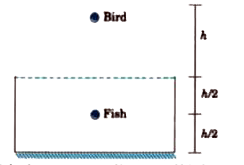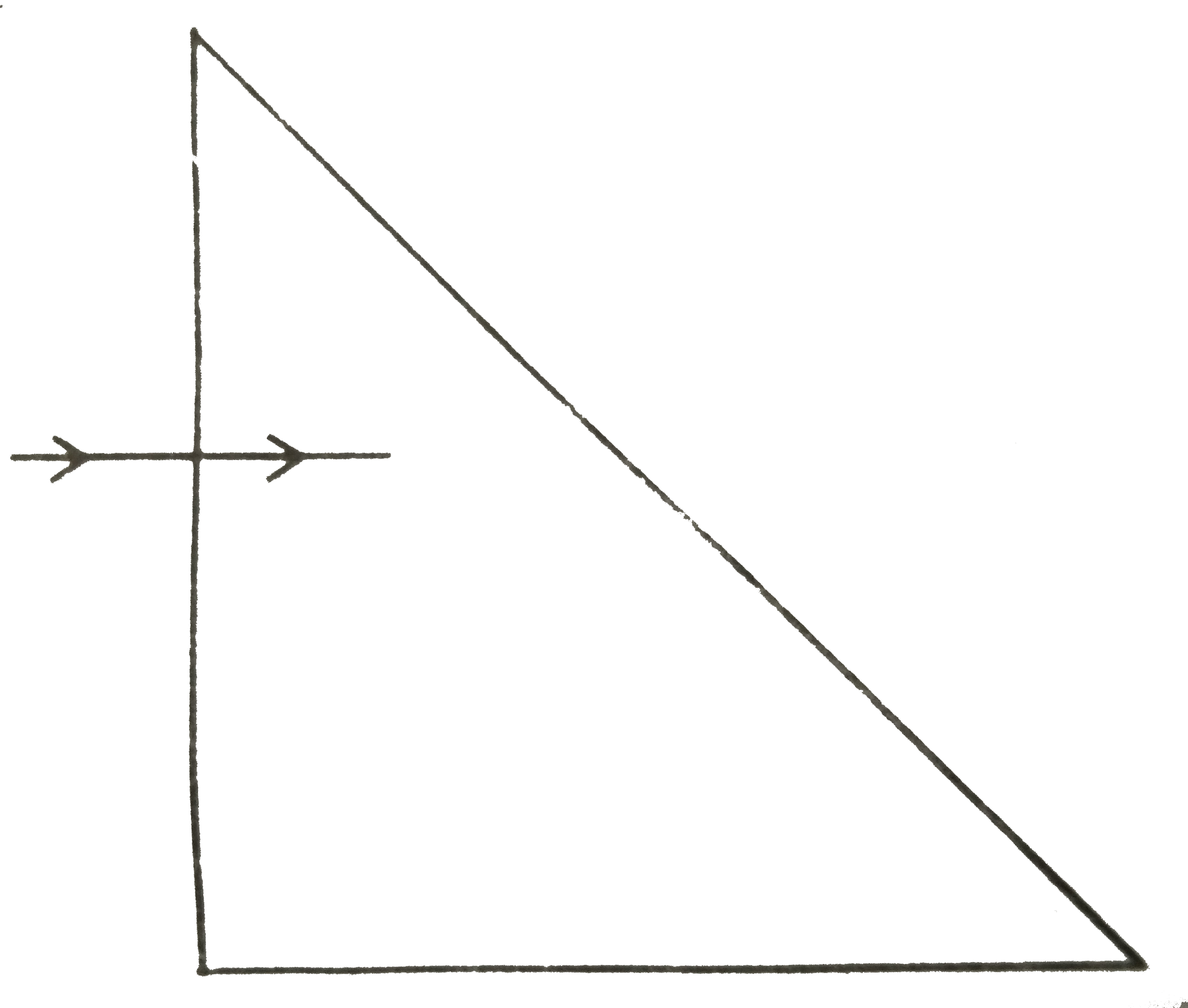Complete Solutions to Higher Order Thinking Skills & Advanced Level (QUESTIONS WITH ANSWERS) of chapter RAY OPTICS AND OPTICAL INSTRUMENTS of Class 12 book with complete answers and questions
| Class 12 | PHYSICS |
| Chapter | RAY OPTICS AND OPTICAL INSTRUMENTS |
| MODERN PUBLICATION | Higher Order Thinking Skills & Advanced Level (QUESTIONS WITH ANSWERS) |
| Number Of Questions | 20 |
| Academic Year | 2023-24 |
A light ray inclined at an angle `30^(@)` with the horizontal falls on a plane mirror and after reflection light ray becomes vertical. At what angle the plane mirror is inclined with the horizontal?
View SolutionAn object is placed at a distance 48 cm from a convex mirror. A plane mirror is placed in between at a distance 16 cm from convex mirror. It is found that virtual images formed by both the mirrors coincide. What is focal length of convex mirror?
View SolutionRadius of the Moon is `1.74 xx 10^(6)` m and its distance from the Earth is `3.82 xx 10^(8)`m. A concave mirror of focal length 20 m is used to form the image of the Moon. What will be the radius of the image of the Moon?
View SolutionTwo concave mirrors of equal focal lengths are placed facing each other with their principal axes coinciding. An object O is to be placed at the mid-point between mirrors. What should be the separation between mirrors so that only one image is formed?
View SolutionOne face of prism of refracting angle `30^@` and refractive index `1.414` is silvered. At what angle must a ray of light fall on the unsilvered face so that it retraces its path out of the prism ?
View SolutionA plane mirror is fixed at the bottom of a vessel as shown in the figure. Water of refractive index `mu` is filled up to a height h in the vessel. There is a fish at a height `h//2` from bottom of vessel and there is a bird at a height h above the surface of water in the vessel.

(a) Calculate apparent distance of bird as seen by the fish.
(b) Calculate apparent distance of image of bird in mirror as seen by the fish.
(c) Calculate apparent distance of fish as seen by the bird.
(d) Calculate apparent distance of image of fish in the mirror as seen by the bird.
View SolutionA ray of light is incident at an angle of `60^(@)` on one face of a rectangular glass slab of thickness `0.1 m`, and refractive index `1.5`.Calculate the lateral shift produced.
View SolutionThere is a cylindrical vessel of radius 10 cm and a cylindrical glass piece of radius 5 cm and height 10 cm is kept inside it. Volume of water `950 pi cm^(3)` is poured into it. Bottom of the glass piece is seen with paraxial rays. What will be the apparent depth of bottom of glass cylinder? Index of refraction of glass is `3//2` and that of water is `4//3`.
View SolutionA small fish, 0.4m below the surface of a lake, is viewed through a simple converging lens of focal length 3m. The lens in kept at 0.2m above the water surface such that the fish lies on the optical axis of the lens. Find the image of the fish seen by the observer. The refractive index of water is `4//3`.
View SolutionThe distance between two point sources of light is `24cm.` Find out where would you place a converging lens of focal length `9cm,` so that the images of both the sources are formed at the same point.
View SolutionThere is a thin symmetric bi-convex lens with radius of curvature for its surface to be 40 cm. One surface of the lens is silvered to make it reflecting from inner side. What will be the focal length of equivalent concave mirror?
View SolutionA thin converging lens with focal length `f = 25 cm` projects the image of an object on a screen removed from the lens by a distance `l == 5.0 m`. Then the screen was draws closer to the lens by a distance `Delta l = 18 cm`. By what distance should the object be shifted for its image to become sharp again ?
View SolutionThere is a glass `(mu=1.5)` biconvex lens of radius of curvature 5 cm and thickness of the lens is also 5 cm. An object is placed at a distance 20 cm from the front surface of lens. Locate its final image.
View SolutionIf separation between an object and a screen is D, then prove that D must be greater or equal to four times of focal length of convex lens. Also prove that there are two positions of lens for which real image of object can be projected on screen. If d is separation between these two positions of lens then what will be the focal length of lens in terms of D and d.
View SolutionThere is a glass sphere of radius 20 cm having refractive index 1.5. A point object is embedded inside it at a distance 6 cm to the left of the centre. Locate the image for observer looking from left. Locate the image for observer looking from right.
View SolutionA glass rod having square cross-section is bent into the shape as shown in the figure. The radius of the inner semi-circle is R and width of the rod is d. Find the minimum value of `d//R` so that the light that enters at A will emerge at B. Refractive index of glass is `mu=1.5`

View SolutionWater is filled up to a height of 13 cm in a jar. Apparent depth of a point placed at the bottom is measured by a microscope and it found to be 10 cm. What is refractive index of water? Now water is replaced by another liquid of refractive index 1.6 up to the same height. By what distance must the microscope be moved in order to focus at the point on the bottom of jar?
View SolutionA travelling microscope is focussed on to a scratch on the bottom of a beaker. Water of refractive index `(4)/(3)` is poured in it. Then the microscope is to be lifted through 2 cm focus it again. Find the depth of water in the beaker.
View SolutionThe angle of minimum deviation measured with a prism is `30^(@)` and the angle of prism is `60^(@)`. The refractive index of prism material is
View Solution
A ray of ligh is incident normally on one of the faces of right
angled isosceles prism as shhown above. It undergoes total
internal reflection from hypotenuse. Which on of the
following is the minimum refractive index of the material of
the prism?
View Solution
Higher Order Thinking Skills & Advanced Level (QUESTIONS WITH ANSWERS) questions and complete solutions for chapter RAY OPTICS AND OPTICAL INSTRUMENTS of MODERN PUBLISHERS PHYSICS (HINGLISH) of Class 12
All Exercises from MODERN PUBLICATION Class 12 PHYSICS RAY OPTICS AND OPTICAL INSTRUMENTS
- CHAPTER PRACTICE TEST
- Conceptual Questions
- Higher Order Thinking Skills & Advanced Level (QUESTIONS WITH ANSWERS)
- NCERT (EXemplar Problems Obejective Questions) (Multiple Choice Questions (Type-I)
- NCERT (EXemplar Problems Obejective Questions) (Multiple Choice Questions (Type-II)
- NCERT (Exemplar Problems Subjective Questions) (Very Short Answer Type Questions)
- NCERT FILE SOLVED (TEXT BOOK EXERCISES)
- OBJECTIVE TYPE QUESTIONS (A. MULTIPLE CHOICE QUESTIONS)
- OBJECTIVE TYPE QUESTIONS (ASSERTION REASON TYPE QUESTIONS)
- OBJECTIVE TYPE QUESTIONS (B. MULTIPLE CHOICE QUESTIONS)
- OBJECTIVE TYPE QUESTIONS (C. MULTIPLE CHOICE QUESTIONS)
- OBJECTIVE TYPE QUESTIONS (D. MULTIPLE CHOICE QUESTIONS)
- OBJECTIVE TYPE QUESTIONS (INTEGER TYPE QUESTIONS)
- OBJECTIVE TYPE QUESTIONS (JEE (ADVANCED) FOR IIT ENTRANCE)
- OBJECTIVE TYPE QUESTIONS (JEE (MAIN) & OTHER STATE BOARDS FOR ENGINEERING ENTRANCE)
- OBJECTIVE TYPE QUESTIONS (MATCHING TYPE QUESTIONS)
- OBJECTIVE TYPE QUESTIONS (MATRIX MATCH TYPE QUESTIONS)
- PRACTICE PROBLEMS (1)
- PRACTICE PROBLEMS (10)
- PRACTICE PROBLEMS (11)
- PRACTICE PROBLEMS (2)
- PRACTICE PROBLEMS (3)
- PRACTICE PROBLEMS (4)
- PRACTICE PROBLEMS (5)
- PRACTICE PROBLEMS (6)
- PRACTICE PROBLEMS (7)
- PRACTICE PROBLEMS (8)
- PRACTICE PROBLEMS (9)
- Revision Exercises (Additional Questions)
- Revision Exercises (Fill in the Blanks)
- Revision Exercises (Long Answer Questions)
- Revision Exercises (Numerical Problems)
- Revision Exercises (Short Answer Questions)
- Revision Exercises (Very Short Answer Questions)
- SOLVED EXAMPLES
- Tough & Tricky (PROBLEMS)